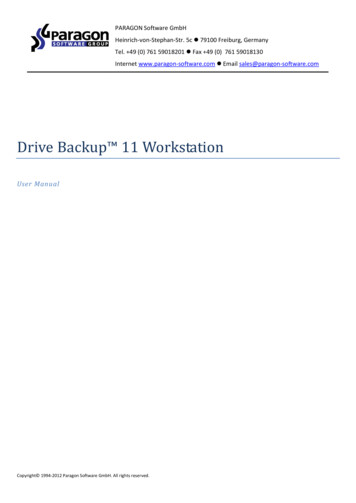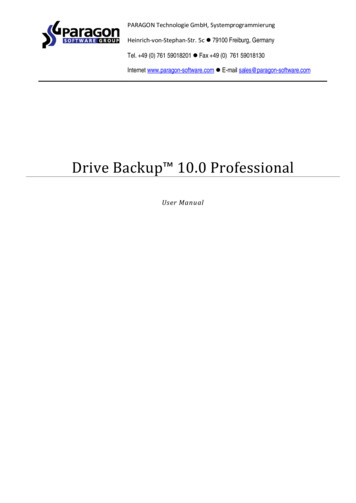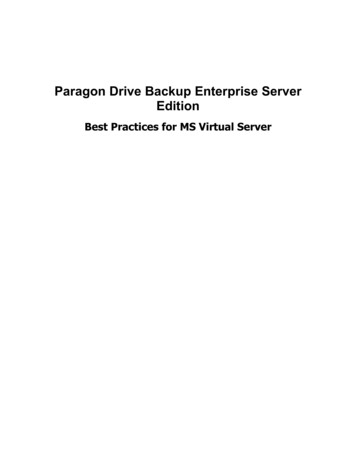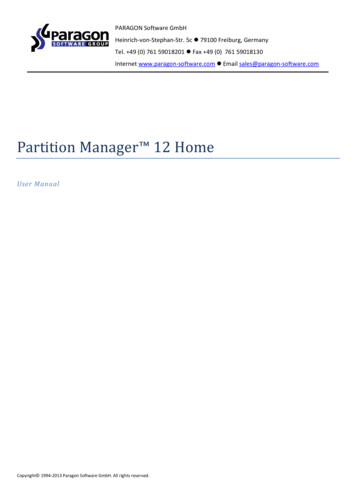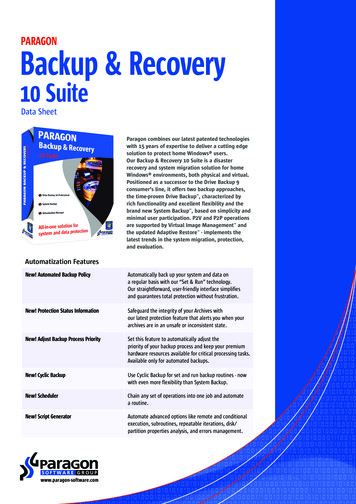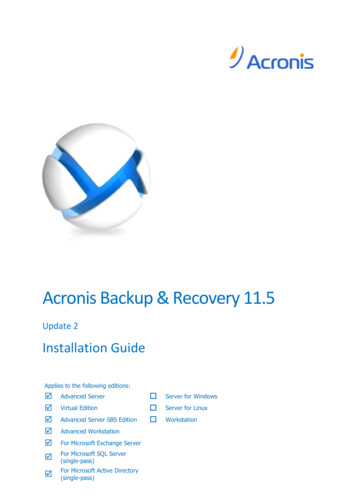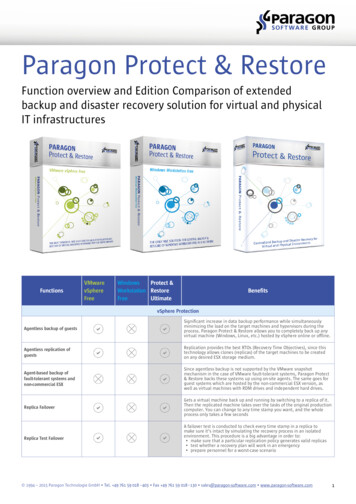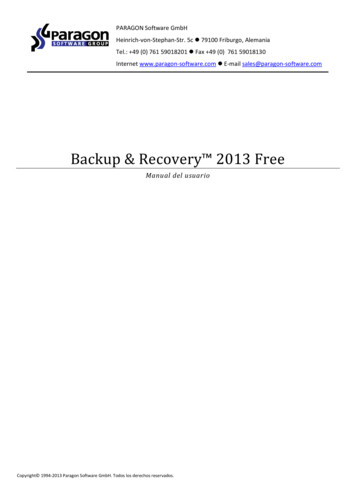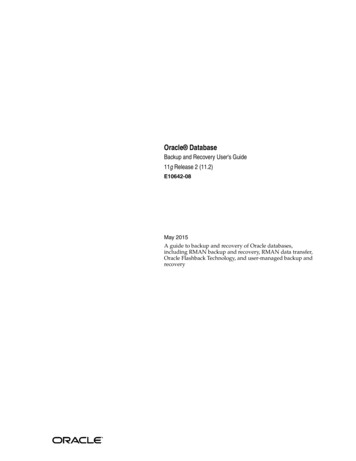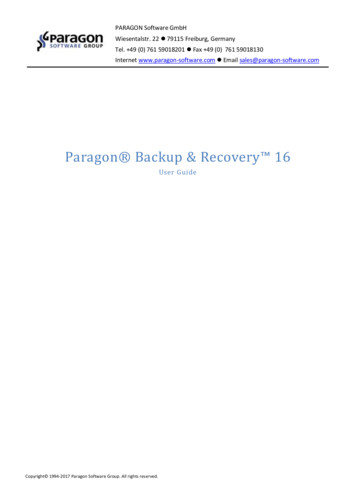
Transcription
PARAGON Software GmbHWiesentalstr. 22 79115 Freiburg, GermanyTel. 49 (0) 761 59018201 Fax 49 (0) 761 59018130Internet www.paragon-software.com Email sales@paragon-software.comParagon Backup & Recovery 16User GuideCopyright 1994-2017 Paragon Software Group. All rights reserved.
2Table of ContentsProduct Overview . 4Getting Started . 4Product Components . 4System Requirements . 4Installation . 5First Start . 5Changing Program Settings . 12Application Section . 12Virtual Mode Options . 12CD/DVD/BD Recording Options. 12Backup Section . 13Backup Image Options . 13Copy and Backup Options . 14Run during Backup Options. 14VD Container Options . 16Building Recovery Media. 16Booting from Recovery Media . 20Protecting System and Data . 21Backup Scenarios . 21Configuring a One-shot Backup Task . 21Configuring a Regular Backup Routine . 27Checking Backup Integrity. 32Managing Backup Jobs. 33Windows Restore Scenarios . 36Restoring Individual Files and Folders . 36Restoring an Entire Disk or Separate Volumes. 37Mounting a Backup Image . 39Transferring Files between Storages . 41WinPE Restore Scenarios . 43Restoring a Failed System . 43Fixing Boot Problems . 47Extra WinPE Scenarios . 49Unlocking Bitlocked Volumes . 49Adding Specific Drivers . 51Configuring Network. 52Copyright 1994-2017 Paragon Software Group. All rights reserved.
3Network Troubleshooter . 54Using the Command Prompt . 56Managing Partitions and Disks . 57Basic Partitioning Tasks . 57Creating a Partition . 57Formatting a Partition. 58Deleting a Partition . 59Moving/Resizing a Partition . 60Changing Volume Label . 60Changing Drive Letter . 61Updating MBR . 61Getting Disk/Partition Properties . 62Advanced Partitioning Tasks . 63Converting File System . 63Hiding/Unhiding Partition . 64Making Partition Active/Inactive . 64Check a Partition for Problems . 65Checking File System Integrity . 65Troubleshooting . 66Copyright 1994-2017 Paragon Software Group. All rights reserved.
4Product OverviewBackup & Recovery 16 is an easy-to-use tool for reliable backup of an entire computer, individual volumes or files.It helps to get consistent point-in-time copies of your PC including OS, running applications, user settings and alldata in such a way that you don’t even feel any discomfort. Three predefined backup strategies simplify setup ofregular backup routines. Full backup images followed by incremental updates of changed data since the lastbackup strengthened by data retention keep your data precisely up to date with minimal effort and backupstorage footprint. Backup data is allowed to store on a local or external device or a network share.For advanced users, there’s a way to create comprehensive backup policies that utilize full, incremental, anddifferential backup methods and their combinations, where backup runs can be scheduled from every hour tillcertain days of the month, or evoked by a certain event (system start or user logon).Several restore options are available for you to rule out an emergency situation as quickly as possible, from fastretrieval of specific files from a backup image, to complete restore of your computer to an earlier state withoutlosing data, reinstalling and reconfiguring your programs. Even when OS fails to start up, you still have a chance toget everything back on track by loading your PC from a WinPE-based rescue media prepared beforehand.In this guide you will find the answers to many of the technical questions, which might arise while using ourprogram.Our company is constantly releasing new versions and updates to its software, that's whyimages shown in this manual may be different from what you see on your screen.Getting StartedProduct Components Windows installation package for regular system and data protection. It’s the main component of theproduct that includes all the necessary tools to help you safe yourself from a system failure, hardwaremalfunction or a human factor. WinPE bootable environment for disaster recovery or data retrieval. You can prepare it on a USB thumbdrive or in an ISO file with the program’s wizard (highly recommended).System RequirementsFor the Windows installation package Windows 7 SP1 and later Opened ports in Firewall: inbound and outbound 80, 443During the installation additional free space (up to 1GB) will be required.For the WinPE bootable environment Intel Pentium III CPU or its equivalent, with 1000 MHz processor clock speed At least 1 GB of RAM SVGA video adapter and monitor KeyboardCopyright 1994-2017 Paragon Software Group. All rights reserved.
5 MouseAdditional requirements Network card to send/retrieve data to/from a network computer Recordable CD/DVD drive to burn data to compact discs External USB hard drive to store dataInstallationBefore the installation, please make sure the systems requirements are met. If everything is OK, please do thefollowing to install the product:In case there is some previous version of the program installed on the computer, theprogram will offer the user to uninstall it first.1. Click on the supplied setup file to initiate the installation. First your system will be checked for thepresence of Visual Studio C 2015 Redistributable and if not found, it will be installed automatically(comes with the installation package). Note! Before installing this library in Windows 8.1, the following OSupdates should be present: KB2919442, KB2919355.2. Then your system will be checked for the presence of Microsoft .NET 4.0 or later and if not found, it willbe downloaded from Microsoft’s website and then installed.3. The Welcome page will inform that the application is being installed. Click Next to continue.4. Please Read Paragon License Agreement carefully and then select the appropriate option to accept.Otherwise you won’t be able to proceed with the installation.5. The final page reports the end of the setup process. Click Finish to complete the wizard.First StartAfter the installation you can see an icon of Backup & Recovery on the Windows desktop. Double click it to getaccess to the program interface.Copyright 1994-2017 Paragon Software Group. All rights reserved.
6The upper area of the main window contains several tabs: Home and Tools.HomeUse this tab to change the program settings, build bootable recovery media, collect program logs, or go toParagon’s website to download a free update, register the product, visit Paragon’s Knowledge Base, etc.For more details, please consult the following chapters:-Changing Program Settings-Building Recovery Media-TroubleshootingCopyright 1994-2017 Paragon Software Group. All rights reserved.
7ToolsIt is displayed each time you launch the program. Use this tab to see the layout of system storage devices, openprogram wizards and dialogs, monitor backup activities and some other actions.By default, the program does not accomplish operations that may destroy the on-disk data (format, delete,restore, etc.) immediately, but places them on a special list (the so-called virtual mode). First it helps to avoidpossible mistakes as you should confirm all provided changes. Second it saves your time and effort whenexecuting several operations, as you don’t need to wait for each operation to physically complete beforeproceeding to the next operation.A corresponding bar appears in the upper area after you accomplish a potentially dangerous operation. Apply. Click to physically execute pending changes. Discard. Click to cancel all pending changes. Show changes. Click to see and manage pending changes.Copyright 1994-2017 Paragon Software Group. All rights reserved.
8Select Old disk layout to see your disks before accomplishing pending changes.Select New disk layout to see your disks after accomplishing pending changes. Use the arrow buttonsbelow to see how the target disk layout changes after each operation.Copyright 1994-2017 Paragon Software Group. All rights reserved.
9 Undo. Click to cancel the last pending operation. Redo. Click to cancel the last undo pending operation. Generate script. Generate a script out of all pending changes. A script may describe one or severaloperations with macro-language commands. The program installation package includes an interpreterutility – SCRIPTS.exe that allows executing any set of operations automatically in the unattended mode.For more details, please consult Using the Command Prompt.If necessary, you can change the default location and filename for the created script file.To learn more about scripts, please consult the Paragon Scripting Language manual.Disk MapThe Disk Map displays the layout of storage devices. Each device is represented with a rectangle bar that containssmall-sized bars, which represent partitions or logical disks. By looking at the size of the bar’s shaded area it ispossible to estimate the used disk space.Large-sized bars display the following information about storage devices: Type (physical, virtual), Used partitioning scheme (MBR or GPT), Total capacity.Copyright 1994-2017 Paragon Software Group. All rights reserved.
10Small-sized bars display the following information about logical disks and blocks of free space: Volume label (if exists), Total size, File system.Left click a disk, volume, or block of free space to call a context-sensitive menu with detailed information on theselected object and a list of available operations.For more details, please consult the following chapters:-Protecting System and Data-Managing Partitions and DisksWizardsFor your convenience the program wizards are grouped into several tabs. Use the arrow buttons to switchbetween them. Select Create single backup to configure a one-shot backup task. For more details, please consultConfiguring a One-shot Backup Task. Select Create backup job to configure a regular backup routine according to one of the predefined backupstrategies. For more details, please consult Configuring a Regular Backup Routine. Select Restore backup to configure a restore operation. For more details, please consult WindowsRestore Scenarios. Select File transfer to copy files or directories between local, external, or network storages. For moredetails, please consult Transferring Files between Storages.Management Tabs Select My Computer (opened by default) to see the layout of storage devices. Select My Backups Single backups to see all configured one-shot backup tasks or My Backups Backup jobs to see configured regular backup routines. Left click a backup image to call a contextsensitive menu with detailed information on the selected object and a list of available operations.Copyright 1994-2017 Paragon Software Group. All rights reserved.
11For more details, please consult the following chapters: -Restoring Individual Files and Folders-Restoring an Entire Disk or Separate Volumes-Checking Backup Integrity-Mounting a Backup ImageSelect My Activities to see completed, scheduled and currently executed operations and their statuses.For any scheduled backup job you can call a context-sensitive menu with detailed information on the selectedobject and a list of available operations. For more details, please consult Managing Backup Jobs.Copyright 1994-2017 Paragon Software Group. All rights reserved.
12Changing Program SettingsSelect Home Settings to access the program settings. All settings are grouped into several sections, whichfunctions are described in the following paragraphs. By selecting a section from the list, you can open a set ofoptions.Application SectionVirtual Mode Options Allow virtual mode (enabled by default). The virtual mode is an effective way of protection from anytroubles, since no potentially dangerous operation is executed until confirmation, thus giving you asecond chance to weigh all pros and cons of this or that particular operation. For more details, pleaseconsult Tools. Close progress dialog automatically. Mark the checkbox to automatically close the progress dialog afteraccomplishing operations.CD/DVD/BD Recording OptionsCopyright 1994-2017 Paragon Software Group. All rights reserved.
13 Burn every CD/DVD/BD to the end. By default, the program does not create ISO 9660 compliant burningsessions, as it processes data on-the-fly and can only estimate the resulted session size. That’s why nothird party tool will get access to the recorded data. To tackle the issue, mark the checkbox to make theprogram create a standard Disk-at-Once session. It may slow down the burning process, as everyCD/DVD/BD will be recorded up to the end, no matter how much actual information to contain. Recording speed. Define how fast compact discs should be recorded (minimum, normal and maximum).Besides there is automatic mode when the program sets the most appropriate speed for each disc. Bootable image. That’s the image to be placed with backup data. By default, the program prompts you touse the Linux/DOS recovery environment, which you change to any other bootable ISO image. Boot mode. Choose whether to make bootable all recorded discs, only the first one for a session, orwithout that function at all. ISO image folder. If you decide not to physically burn a CD/DVD/BD disc, but create an ISO image file, thisvery folder will be used to store these images.Backup SectionBackup Image Options Control archive integrity (enabled by default). Use this option to make sure all backup images createdwith the program are 100 percent flawless. If you decided not to control the archive integrity, the backupoperation would take about 3-5% less time. Compression level. Select the default compression level for all created backup images from the pull-downlist. Image split. By default, every backup image will be split to files of 4GB. This can help to avoid problemscaused by a maximum file size limitation of your file system (e.g. 4GB for FAT32). Use the spinner controlto set another size or disable this option if necessary.Copyright 1994-2017 Paragon Software Group. All rights reserved.
14Copy and Backup Options HDD raw processing. Mark the checkbox to back up a hard disk in the sector-by-sector mode, thusignoring its information structure (e.g. unallocated space or unused sectors of existing partitions will beprocessed as well). This can help to avoid problems with hidden data created by certain applications orthe system administrator. If you enable this option, the operation will take more time to complete. Partition raw processing. Mark the checkbox to back up a partition in the sector-by-sector mode tosuccessfully process unknown file systems. If you enable this option for processing supported file systems,the operation will take more time to complete. Skip archive files stored in archive library. By default, backup images registered in the archive databasewill be skipped from processing, thus reducing the operation time and the resulted backup size. Automatic BCD Update. If necessary, unmark the checkbox to suppress automatic update of BCD (BootConfiguration Data) after copy/restore operations.Run during Backup OptionsIn this section you can specify external applications to execute at various phases of the backup process in order toobtain consistent backup images of systems with high availability requirements (MS SQL, MS Exchange, etc.). Thepoint is to provide a coherent state of all open files and databases involved in a backup, taking into account thatapplications may still keep writing to disks.Copyright 1994-2017 Paragon Software Group. All rights reserved.
15Actually a backup process consists of two phases: the preparation phase (snapshot) and the data-copying phase.There are three points of the backup when external commands/programs can be launched: Execute at the beginning of the backup process before taking a snapshot. Specify an executable file thatwill help you to prepare running applications for taking a snapshot. It may contain specificcommands/programs to delete unnecessary files, suspend services, flush transactions or caches, etc.Everything depends on the used applications. Execute after taking a snapshot. Specify an executable file that will run just after taking a snapshot. Itmay contain specific commands/programs, e.g. to resume the previously suspended services, etc.Everything depends on the used applications. Execute after finishing the backup process. Specify an executable file that will run after the backupprocess has been accomplished. It may include commands/ programs that will move the backup image toa particular location, etc.By clicking the Browse button you can get into a browser-like window to choose an executable file.The program supports three types of executable files (.exe, .bat, .cmd). It’s up to you to write batch files to safelyprepare applications for backup. There are certain general requirements for that: All programs and commands must execute sequentially and finish before the .bat file completes its work. It is recommended to use external commands/programs in the following format - Start/waitprogram.exe. The wait option will help to start an application and wait until it completes its work. Thisguarantees all included commands/programs complete their execution before the batch file does.You’re allowed to set parameters for an executable file directly from the line. However, if the file path containsword gaps it is necessary to enclose it in quotes in order to make the program distinguish between the path andthe used parameters.Copyright 1994-2017 Paragon Software Group. All rights reserved.
16VD Container Options Unknown partitions policy. Here you can define behavior for processing unknown or unformattedpartitions (skip from backup, process in the sector-by-sector mode, or ask the user each time this type ofpartition has been found). Virtual container type. By default, the program is configured to back up to pVHD (Paragon Virtual HardDrive). Use this option to switch the resulted virtual container to VHD, VHDX, or VMDK. Please note thatthe use of pVHD enables to get full backup images several times smaller than the original objects, whileincremental updates – dozens of times smaller when comparing to VHD, VHDX or VMDK, which havesome fixed size of blocks, not dynamic. Besides encryption and password protection are only available forpVHD. However, if you’re having a VMware or Microsoft hypervisor at your disposal and are planning todo instant virtualization, please make sure the used backup format matches your hypervisor.Building Recovery MediaThe program includes a user-friendly wizard that will guide you through the process of creating a WinPE-basedrecovery media on a USB thumb drive or in an ISO file to later burn it to CD/DVD. For advanced users, there arecapabilities to add drivers for specific hardware devices, configure network settings, and map network shares inthe process.1. Select Home Recovery Media Builder.2. The welcome page introduces the wizard’s functionality. Besides you can see two options here:Copyright 1994-2017 Paragon Software Group. All rights reserved.
17 Advanced mode. Please mark this option if you’d like the future bootable media to have pre-configurednetwork settings, mapped network resources, or injected drivers for specific storage controllers ornetwork cards. Use ADK/WAIK. Recovery Media Builder doesn’t require Windows Assessment and Deployment Kit (ADK)or Automated Installation Kit (WAIK) to be installed in the system to build a WinPE-based environment, asit can directly use WIM image inside the operating system. However, some system builders remove thisimage from preinstalled Windows OS. If this is your case, mark the option to use ADK/WAIK. You will alsoneed it to create an ISO image of the WinPE environment.WAIK/ADK is a Microsoft’s proprietary tool and can be obtained from its Download Centerfor free. Please note that you need a genuine Windows installation to be able to downloadthis tool. Moreover you will need to download a version, which is suitable for yourWindows OS – Recovery Media Builder automatically detects your system and offers therequired download link.3. Click on Removable flash media, then select a thumb drive of at least 512MB in size from the list of flashmemory devices available in the system at the moment (if several). If you’d like to create an ISO image ofthe WinPE environment, please use the corresponding option.4. If selecting a thumb drive, the wizard will warn you that all data on it will be deleted.Additional steps of the advanced mode5. Inject additional drivers for specific storage controllers or network cards. First click on the required link.Copyright 1994-2017 Paragon Software Group. All rights reserved.
18In the opened dialog browse for an .INF file of the required driver package located on a floppy disk, localdisk, CD/DVD or a network share.If successfully injected, you can see the specified driver on the list. If you’d like to add another driver,please repeat the procedure.Recovery Media Builder can build 32-bit WinPE media configured to the uEFI mode, whichis the only type compatible with Windows pads running on Intel Atom.By default, WinPE environment doesn’t support touch screens, thus Windows pads can onlybe managed by mouse and/or keyboard. You can add required drivers however throughour driver injector.6. Set up a network connection if needed. You’ve got several options to choose from:Copyright 1994-2017 Paragon Software Group. All rights reserved.
19 Connect to network automatically. Specify the following parameters if you’d like to have an activenetwork connection once the bootable environment has been started up:-A network adapter to use. Select a network adapter (if several in the system) to be used for thenetwork connection.-IP address settings. Choose whether to get an IP address automatically from a DHCP server or setit manually. Connect to network manually. If selecting this option you will be prompted to configure networkproperties each time the computer has been started up from the bootable media. Skip network adjustment. Please use this option if you don’t need network support on the bootablemedia.7. Map a network share if needed (not be available if selecting Skip network adjustment on the previousstep). You’ve got several options to choose from: Mount a network share automatically. Mark this option if you’d like to have a mapped networkresource once the computer has been started up from the bootable media. Manually type in a path tothe required network share or click Browse to find it, then provide user credentials if necessary.With no pre-defined user credentials your network share will be attempted to map underthe Guest account.Please use back slashes for WinPE-based media, like \\server\share, while for Linux –forward slashes, like //server/share. Mount a network share manually. If selecting this option you will be prompted to map a networkresource each time the computer has been started up from the bootable media.Copyright 1994-2017 Paragon Software Group. All rights reserved.
20 Don’t mount a network share. Please use this option if you don’t need to map network resources.Additional steps if using WAIK/ADK8. If you install WAIK or ADK by their default locations, the wizard automatically detects it. Otherwise, youwill need to browse for the required folder. If you haven’t installed one of these tools yet, click DownloadWAIK/ADK to get them directly from the
regular backup routines. Full backup images followed by incremental updates of changed data since the last backup strengthened by data retention keep your data precisely up to date with minimal effort and backup storage footprint. Backup data is allowed to store on a local or external device or a network share.

